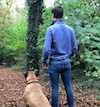What Is Your Canine Trying To Tell You?
A phrase you often hear from dog owners is, “Oh, but if they could only speak!” What is your canine trying to tell you?
Some of us must call our dog’s name hundreds of times each day and we would love for our faithful friend to tell us their worries and woes, and equally their highs and what they look forward to. Unfortunately, we’re still much in the dark, but dogs can tell us plenty!
If we watch their body, their behavior and their reactions, we can soon figure out if they are happy or worried, excited or nervous.
We’ve collected our top four tips on how to figure out what your dog is trying to tell you.

Figure Out Their Baseline
First of all, you need to understand how your dog behaves in a relaxed state:
- How do they walk?
- How does their tail hang?
- Are their ears naturally up or flat?
This gives you the norm. Once you have figured out their baseline, you know that any behavior different from this is indicating a change in emotion. If you are in a busy place, does your dog look at you for reassurance? Do you miss this because you are too distracted by other things? Observe your pup. A simple, “It’s OK!” may be all they need to continue walking forward.
Notice The Subtleties
It’s easy to end up in a situation where your dog has completely shut down and no amount of cajoling or treating can encourage them to do something. Or equally, they are barking and lunging at something or someone walking past. The thing is, these are often totally preventable situations.
There are very subtle behaviors that dogs demonstrate which can tell you they are getting stressed. This can lead to anxious and nervous behavior, or aggression, depending on how your dog chooses to deal with his emotions.
Watch for fast eyes, yawning, lip-licking, or turning away. You may notice excessive drooling or they may pant in the absence of food or exercise. Their bodies may go rigid or tense. They may alter their gait – how they walk. Any of these may suggest your pooch isn’t happy about something.
Understand Quick Escalations
There may be occasions where your dog will get startled if they hear a loud noise, or a truck goes past faster than usual. Your dog may jump back or to the side and you may notice hackles on their neck and along their back. This may have just been a surprise and not necessarily something to worry about.
It’s worth taking note though. You can be alert for future occurrences. If it happens again, they may not even flinch this time, or they may again become startled. If this is the case, it could be worth re-socializing the event.
Related:
Understanding the Body Language of German Shepherds
Watch Their Whole Body
To get an understanding of what your dog is trying to tell you, watch their whole body. Look at their eyes. Wide eyes allow them to gain as much information about their environment as possible, which suggests they are on the lookout for a threat.
The same with their ears – erect or ears that are pulled back allows them to hear as much as they can so they can figure out if there is something to worry about.
Notice their tail – a wagging tail can still signal stress or worry if it’s wagging slower or lower than usual.
Watch how they walk. A tentative, slow walk suggests your dog is stressed; they are trying to draw as little attention to themselves as possible. The same goes for if they are cowering or trying to escape. A rigid, tense body lets us know they aren’t happy about something.
When things escalate, you may see frothing at the mouth, barking, snarling, or lunging.
Any of these signs tell you that your dog is struggling in that situation and they need to be removed from it. Redirect your dog to a calm area and think about what went on, so you can assess what triggered the reaction.
If you are concerned about how your dog manages certain situations, or you are worried they are getting stressed quite frequently, seek the advice of a qualified professional.
Summary
The world is pretty fast-paced and we’re asking a lot of our four-legged friends when we take them into those busy places. But we can figure out how they are coping with it by watching their behavior. They will tell us all we need to know, we just need to know what to look for.
~~~~~
“What Is Your Canine Trying To Tell You? Dog Body Language Revealed”
 Guest Writer: John Woods is the founder of All Things Dogs, a member of the Association of Professional Dog Trainers, a graduate in Animal Behavior & Welfare, and recognized author by the Dog Writers Association of America.
Guest Writer: John Woods is the founder of All Things Dogs, a member of the Association of Professional Dog Trainers, a graduate in Animal Behavior & Welfare, and recognized author by the Dog Writers Association of America.
All Things Dogs | Dog Breeds, Training and Behavior
*** Please Share ***
What Is Your Canine Trying To Tell You? Dog Body Language Revealed #PetBLogShare Share on X![]()
MY QUESTION FOR YOU:
Can you understand your dog’s body language?
*** Leave your comment below. ***
(It’s just sexy!)

Peace
DISCLOSURE: Animal Bliss is a participant in the Amazon Services LLC Associates Program, an affiliate advertising program designed to provide a means for us to earn fees by linking to Amazon.com and affiliated sites.
(In other words, we’ll get a very small (teeny tiny) commission from purchases made through links on this website.)
So, go on … Don’t be shy!
Buy Something BIG and Expensive!
Buy a Jaguar. Or a Ferrari.
Thank you!
- 4 Tips for Maintaining Healthy Weight for Your Cat - December 20, 2019
- 8 Amazing Benefits of CBD for Dogs and Other Pets - December 12, 2019
- Kibble or Canned Pet Food? What Should Your Pet Be Eating? - December 9, 2019

